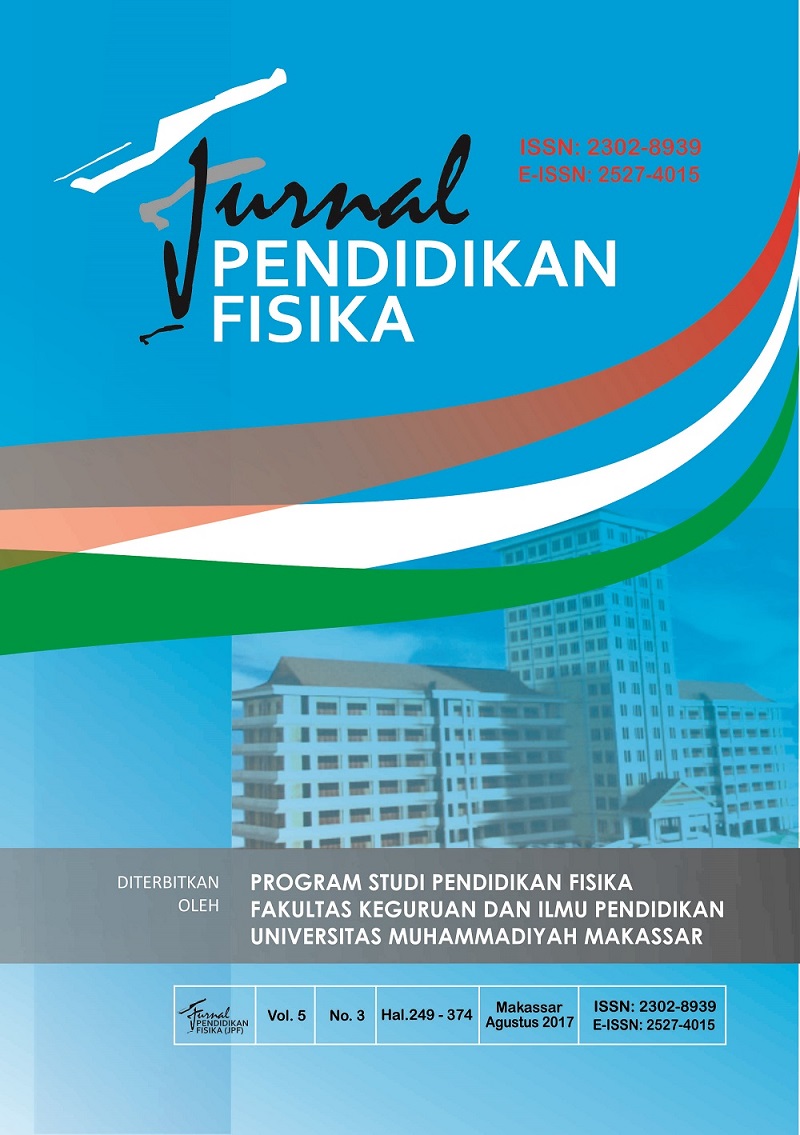Implementasi Metode Pembelajaran GASING (Gampang, Asyik dan Menyenangkan) Terhadap Hasil Belajar Fisika Peserta Didik Kelas X SMA Negeri 3 Polongbangkeng Utara
DOI:
https://doi.org/10.26618/jpf.v5i3.857Abstract
Masalah utama dalam penelitian ini adalah adanya anggapan peserta didik bahwa belajar fisika itu sulit berhubungan dengan rumus-rumus yang harus dihafal serta tidak menyenangkan sehingga dapat berpengaruh pada hasil belajarnya. Adapun tujuan Penelitian ini adalah; 1)Untuk mengetahui besarnya hasil belajar fisika peserta didik sebelum menerapkan metode Gasing; 2)Untuk mengetahui besarnya hasil belajar fisika peserta didik setelah menerapkan metode Gasing. 3)Untuk mengetahui bagaimana peningkatan hasil belajar fisika peserta didik kelas setelah diterapkannya metode Gasing. Jenis penelitian ini adalah penelitian pra eksperimen dengan menggunakan The one Group Pretest-Posttest Design yang dilaksanakan dalam tiga tahap yaitu pre test, pemberian perlakuan, dan post test selama 8 kali pertemuan. Dimana subjek dalam penelitian inipeserta didik kelas X3 SMA Negeri 3 Polongbangkeng Utara tahun ajaran 2016/2017. Instrumen yang digunakan adalah tes hasil belajar fisika peserta didik.Hasil penelitian menunjukkan skor rata-rata hasil belajar fisika peserta didik pada tahap pretest sebesar 8,13 dengan standar deviasi sebesar 3,11, sedangkan skor rata-rata hasil belajar fisika peserta didikpada tahap posttest sebesar 14,71 dengan standar deviasi sebesar 2,37. Nilai rata-rata Gain ternormalisasi sebesar 0,55 yang berada dalam kategori sedang. Dengan demikian dapat disimpulkan bahwa metode Gasing (Gampang, Asyik dan Menyenangkan) dapat meningkatkan hasil belajar fisika peserta didik kelas X SMA Negeri 3 Polongbangkeng Utara.
Kata Kunci: Metode Gasing, Hasil Belajar
The main problem in this research is the perception of students that learning physics is difficult dealing with formulas to be memorized and so unpleasant that may affect the results of their study. The purpose of this research are: 1) To determine the physics learning outcomes of learners before applying the method Gasing. 2) To determine the learning outcomes of physics students after applying the method Gasing. 3) To find out how the learning outcome of students physics class after the implementation methods Gasing. This research is a pre-experimental study using the one-group pretest-posttest design, were implemented in three phases, that is pre-test, giving treatment and post-test, for 8 sessions. Where the subjects in this study X3 grade students of SMA 3 North Polongbangkeng academic year 2016/2017. The instrument used was a test result of studying physics students. The results showed an average score of physics learning outcomes of students in the pretest phase of 8,13 with a standard deviation of 3,11, while the average score of physics learning outcomes of students in the pretest phase of14,71 with a standard deviation of 2,37. The average value gain of 0.55 which are in the moderate category. Thus it can be concluded that the method Gasing (Easy, Fun and Fun) can improve learning outcomes physics students of class X SMA Negeri 3 Polongbangkeng North.
Keywords: Gasing Method, Results Learning
References
Hamalik, Oemar. 2013. Kurikulum dan Pembelajaran. Jakarta: PT. Bumi Aksara.
Sudjana, Nana.2010. Cara Belajar Siswa Aktif dalam Proses Belajar Mengajar. Bandung: Sinar Baru Algensindo.
Wikipedia. “Pembelajaran”. https://id. wikipedia. org/wiki/Pembelajaran (April 2016)
Nasution, S. 1982. Berbagai Pendekatan dalam Proses Belajar Mengajar. Jakarta: Bumi Aksara.
Suprijono, Agus. 2009. Cooperatif Learning Teori & Aplikasi PAIKEM. Yogyakarta: Pustaka Pelajar.
Faizi, Mastur. 2013. Ragam Metode Mengajar Eksakta pada Murid. Jogjakarta: DIVA Press
Faizah, Siti Rizanatul.2012.Efektivitas Penggunaan Strategi Pembelajaran Gasing (Gampang, Asyik, Dan Menyenangkan) Terhadap Hasil Belajar Peserta Didik Man 1 Purwodadi Pada Mata Pelajaran Fisika Kelas X Materi Pokok Gerak. Skripsi diterbitkan. Semarang: Institut Agama Islam Negeri Walisongo.
Sugiyono. 2008. Metode Penelitian Pendidikan Pendekatan Kuantitatif, Kualitatif dan R&D. Bandung: Alfabeta.
Meltzer, D.E, 2002.The Relantionship between Mathematics Preparation and Conceptual Learning Gains in Physics. American Journal of Physics, 70, 7.
Budiyanti, Raehana. 2015. Pengaruh Penggunaan Strategi Pembelajaran GASING (Gampang, Asyik dan Menyenangkan) Terhadap Hasil Belajar Matematika Siswa Kelas VIII SMP Negeri 4 Sungguminasa. Skripsi tidak diterbitkan. Makassar: Universitas Muhammadiyah Makassar.
Admin. 2013. Pembelajaran Fisika Dengan Metode Gasing. http://belajar onlinegratis.com/content/pembelajaran-fisika-dengan- metode-gasing (13 Juni 2013).
Irawan, Nuryahman Wahyu. 2015. Metode Gasing dengan Eksperimen untuk Meningkatan Hasil Belajar Fisika Konsep Mekanik Zat (Hukum Hooke) pada Peserta Didik Kelas X Multimedia SMK Negeri 2 PatiSemester Genap Tahun Ajaran 2014/2015. Makalah disajikan dalam Seminar Nasional Pendidikan Sains, Magister Pendidikan Sains dan Doktor Pendidikan IPA FKIP UNS, Surakarta, 19 November.
Downloads
Published
Issue
Section
License
Copyright:
Authors who publish with this journal agree to the following terms:
1. Authors retain copyright and grant the journal right of first publication with the work simultaneously licensed under a Creative Commons Attribution-ShareAlike 4.0 International License that allows others to share the work with an acknowledgement of the work's authorship and initial publication in this journal.
2. Authors are able to enter into separate, additional contractual arrangements for the non-exclusive distribution of the journal's published version of the work (e.g., post it to an institutional repository or publish it in a book), with an acknowledgement of its initial publication in this journal.
3. Authors are permitted and encouraged to post their work online (e.g., in institutional repositories or on their website) prior to and during the submission process, as it can lead to productive exchanges, as well as earlier and greater citation of published work.
Licence:
Authors are free to:
1. Share: Copy and redistribute the material in any medium or format
2. Adapt: Remix, transform, and build upon the material for any purpose, even commercially.
The licensor cannot revoke these freedoms as long as the authors follow the license terms, which include the following:
1. Attribution: You must give appropriate credit, provide a link to the license, and indicate if changes were made. You may do so in any reasonable manner, but not in any way that suggests the licensor endorses you or your use.
2. ShareAlike: If you remix, transform, or build upon the material, you must distribute your contributions under the same license as the original.
3. No additional restrictions: You may not apply legal terms or technological measures that legally restrict others from doing anything the license permits.
Jurnal Pendidikan Fisika is licensed under a Creative Commons Attribution-ShareAlike 4.0 International License.

